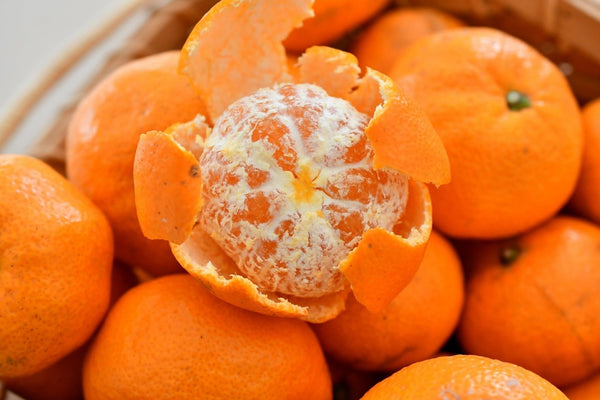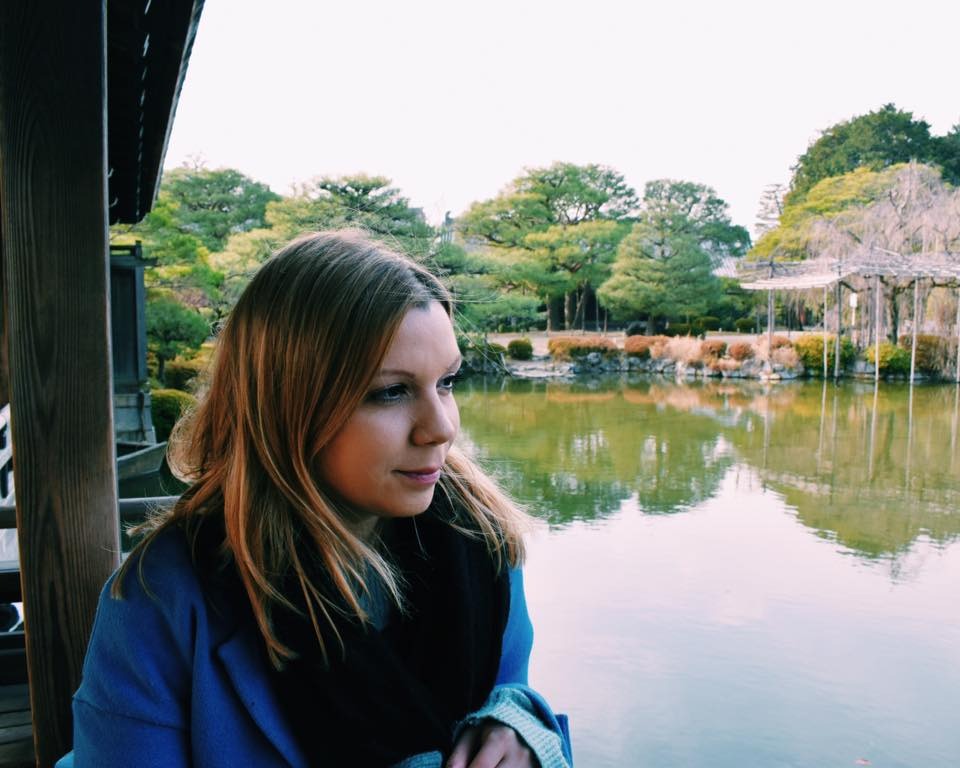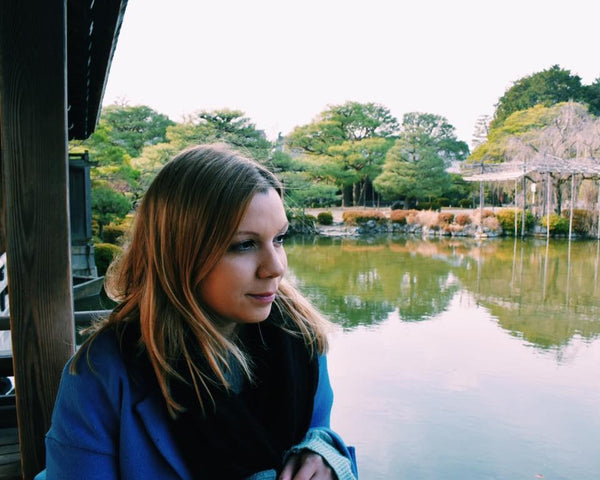
Jump to:
One of the most popular and best-selling fruits in Japan is the mikan, also known as the Japanese mandarin or Japanese tangerine. This small, orange-colored citrus fruit is sweet and juicy, making it a favorite snack or dessert item.
If you’re wondering “Is Japanese mandarin the same as Japanese tangerine?”, the answer is yes! They’re the same fruit, often called mikan in Japan. These mandarins are grown throughout the country and used in a variety of ways, from desserts and alcohol to beauty and even cleaning products.
In this article, we’ll take a deeper dive into the beloved mikan and the different types of mandarins you can try, what kind of dishes and products they are used in, and where and how they are grown in Japan.
Characteristics of Japanese mandarins

Japanese mandarins are small round orange citrus fruits usually averaging between 6-8 centimeters in diameter. They are easy to peel and have a sweet tangy flavor with a juicy texture. In terms of nutrition, Japanese mikan contains vitamins A and C to strengthen the immune system, calcium, potassium, magnesium, and vitamin E.
It is said that consuming two Japanese mikan can provide roughly half to two-thirds of an adult’s recommended daily intake of vitamin C. According to a publication by Wakayama Prefecture, eating three mikan fruits (approximately 300 grams) per day is enough to meet the full daily requirement, suggesting that two mikan would cover most of it.
Mikan are typically eaten during the colder seasons and the growing season for mandarin Japanese extends from October through to March, making them a widely available and cheap fruit to purchase in the supermarket. Out in more rural mikan growing areas like Shikoku, you can also visit mikan farms and pick your own mandarins!
How and where are Japanese mandarins grown?

Mandarins prefer warmer climates and are mainly cultivated in coastal areas west of the Kanto region. Ehime Prefecture, on Shikoku Island, is Japan’s number one citrus producer and produces much of the country’s mandarin orange in Japanese markets. Thanks to its three sources of sunlight, the climate of Ehime is ideal for growing citrus fruits – the sunlight from the sky, the sun reflected off the sea, and the sun reflected up onto the mountains.
Another famous mikan-producing area in Japan is Wakayama, which benefits from a warm climate, a long coastline, and an abundance of forests. Mikan groves can be found in Wakayama’s central Arida region all along the mountains that cover the river and coastline.
Mikan groves are usually located within the mountains in terraced fields with stone walls that are built to retain heat by reflecting the sunlight and preventing landslides. The mikan farmers take great care in growing the fruit, paying close attention to managing the trees by pruning them regularly and also carefully managing the water supply to ensure that the mikan have enough water so that the fruit and leaves don’t drop during the drier summer months.
In Japan, mandarins are divided into four categories according to their ripening times. The first mandarins of the season are harvested in September and are usually tarter and more acidic in flavor compared to the mandarins harvested later on in the season. The late-season mandarins are sweeter and milder in taste and are available to purchase from January until March.
Varieties of Japanese mandarins
There are many different varieties of mikan in Japan, with differences in flavor from tart to sweet. Here are a few of the most popular ones.
Unshu Mikan

The unshu mikan is Japan’s most well-known variety of mandarin and accounts for almost 70% of all citrus fruit sales. It’s harvested between October and February and is rich in sweetness and low in acidity. It is easy to peel, has few seeds, is juicy, and has high sugar content.
Although its origins are not 100% clear, the unshu mikan is believed to have originated in Kagoshima Prefecture over 1,400 years ago, and it began to be cultivated in Ehime during the 1700s. Fruit was considered a luxury item until World War II, but after that, it became widely available and inexpensive.
Maana Mikan

Maana mikan hail from the Maana District located along Ehime’s western coastline. Many of the local families in this area are involved in the mikan growing industry, and about 180 households produce approximately 7,000-8,000 tons of mikan per year. Cultivating these premium quality mandarins is hard work due to the steep slopes of the terraced fields and must be done mainly by manual labor instead of machinery.
This award-winning fruit is known for its thin peel and skin and rich sweet flavor and has been grown in the Maana area since the late 1800s. The landscape provides perfect conditions for the mikan groves to thrive – a warm climate and abundance of sunshine combined with the mineral-rich terraced fields and proximity to the sea.
Kiyomi

The Kiyomi is a hybrid of an unshu mikan and an orange, combining the body and sweetness of the unshu with the aroma and acidity of the orange. It’s harvested between January and April and is around 7-8cm in size.
The Kiyomi was created in 1949 and is named after its place of origin, the Kiyomigata coast in Shizuoka Prefecture. It is usually seedless and is more difficult to peel than the unshu mikan.
Amanatsu

One of the larger varieties of mikan, the amanatsu is around 9.5-10cm in size which is similar to a grapefruit or a large orange. They are also known as natsumikan in Japanese meaning summer mandarin and are harvested between February and June of each year.
This fruit originated in Yamaguchi Prefecture in the 1700s and in Kyushu there is a popular dessert made from amanatsu called Yobuko Yume Amanatsu Jelly. The amanatsu has quite a thick skin so usually requires a knife to cut it open – but the effort is worth it for the bittersweet flavor!
Shiranui

The shiranui is a hybrid of the kiyomi and ponkan orange, approximately 7-9cm in size, and is recognizable for its unusual shape which has a bump on one end. It is harvested between December and May and has a strong sweetness to it.
During the spring they are at their tastiest, when they are fully ripe and at their peak sweetness. Shiranui are packed full of vitamin C and are often used in other products such as orange liqueur, orange juice, or shiranui-flavored candies.
Japanese products featuring mandarins
When it comes to the mikan, they are not just eaten as a delicious fruit snack but are used in a wide range of products from cosmetics to household items. Here are a few popular uses for Japanese mandarins:
Food and Drinks

In Japan, you can find a special kind of café called a fruit parlor, which specializes in sweet desserts made from different types of fruits. Mandarins are used for many of the dishes here such as fruit sandwiches filled with whipped cream and mandarins, fruit parfaits, fruit jellies, and fruit ice cream!
Other food products that mikan can be used in include jams, salad dressings, sauces, fruit juices, liqueurs, beer, and cocktails!
Household Products

When you are finished eating your mandarin be sure not to throw away the peel as this has a variety of uses too! Dried mikan peels are called chimpi in Japanese, and they can be used as household cleaners, by rubbing them on surfaces to remove dirt. Chimpi can also be ground down to make tea, added to bath water to create a citrusy bath experience, and is used as an ingredient in Chinese medicine.
Mikan is also used in scented candles and incense that can be used around the home to create a lovely, fragranced atmosphere!
Beauty Products

Mandarin is also a popular ingredient in skincare products thanks to its abundance of vitamin C which helps to fight free radicals and improve your complexion and skin tone. Mandarin peel oil is also used in hair products as its benefits include making your hair stronger and shinier, treating dry scalps, and reducing hair loss.
Have you ever tried a Japanese tangerine (mikan) before? Which variety is your favorite? Let us know in the comments!


0 comments